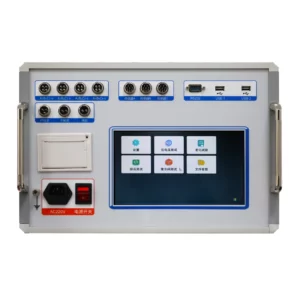Mitigating corona effects during testing with a Hipot Very Low Frequency (VLF) tester involves several strategies to minimize or eliminate corona discharge, which can occur due to high electrical stress on the insulation.
Here’s how the tester handles and mitigates corona effects:
- Optimal Frequency Selection: VLF testers operate at very low frequencies (typically between 0.1 Hz and 0.01 Hz) to reduce the capacitive effect and minimize corona discharge. Lower frequencies reduce stress on the insulation, helping to mitigate corona effects.
- Gradual Voltage Ramp-Up: The tester employs gradual voltage ramp-up procedures to allow the insulation to acclimate to the applied voltage slowly. This minimizes the risk of sudden corona discharge due to rapid voltage changes.
- Controlled Dwell Time: Adequate dwell time, the duration the voltage is maintained at a specified level, is crucial. It allows the insulation to stabilize under the test voltage without inducing corona discharge.
- Monitoring Leakage Current: The Hipot VLF tester continuously monitors leakage current during testing. An increase in leakage current may indicate the onset of corona discharge or partial discharge within the insulation.
- Proper Test Voltage Selection: The tester selects appropriate test voltage levels within the safe operating range for the insulation being tested. Avoiding excessively high voltages reduces the likelihood of corona discharge.
- Adherence to Standards: Test procedures aligned with industry standards or manufacturer recommendations help mitigate corona effects. These standards often specify test parameters that minimize corona discharge risks.
- Smooth Voltage Waveform: VLF testers generate smooth sinusoidal waveforms for the test voltage. Well-shaped waveforms reduce voltage spikes that might trigger corona discharge.
- Electrode Configuration and Shielding: Proper electrode configuration and shielding of the test setup are essential to prevent corona discharge. Careful placement and design of electrodes minimize electric field concentrations that can lead to corona.
- Equipment Maintenance: Regular maintenance and calibration of the Hipot VLF tester ensure its optimal performance and accuracy. Malfunctioning equipment might induce corona discharge during testing.
- Operator Training: Proper training of operators in test procedures, equipment handling, and safety measures minimizes the risk of corona discharge incidents during testing.
By employing these strategies, the Hipot VLF tester aims to minimize corona discharge effects, ensuring accurate and reliable testing of insulation systems while maintaining the safety and integrity of the equipment being tested.
How is the loop resistance tester calibrated and maintained for accuracy?
Calibrating and maintaining a loop resistance tester is essential to ensure its accuracy and reliability in measuring the resistance of electrical circuits or loops. Here are general steps involved in calibrating and maintaining such testers:
- Periodic Calibration: Regular calibration is necessary to maintain accuracy. Follow the manufacturer’s recommended calibration schedule or interval. This calibration is often performed using calibrated resistance standards or references.
- Verification Procedures: Before performing critical measurements, conduct a verification check using known resistors or reference standards to confirm the tester’s accuracy. This quick check ensures that the tester is functioning within acceptable limits.
- Adjustment and Zeroing: Some loop resistance testers allow for adjustments or zeroing to compensate for any drift or deviations from the expected readings. Follow the manufacturer’s guidelines for making adjustments, if applicable.
- Maintenance of Test Leads: Ensure the test leads or probes are in good condition without any damage or wear that could affect the measurements. loop resistance tester Clean the probes regularly and inspect for any signs of degradation.
- Cleanliness and Care: Keep the loop resistance tester clean and free from dirt or debris that could interfere with its components or connections. Handle the equipment with care to prevent damage.
- Battery or Power Source Maintenance: If the tester operates on batteries or has a power source, ensure that it has adequate power and replace batteries or recharge as necessary. Low power levels can affect the accuracy of measurements.
- Environment Considerations: Avoid exposing the tester to extreme temperatures or humidity, as these conditions can affect its performance. Store the equipment in a suitable environment when not in use.
- Regular Inspections: Periodically inspect the tester for any signs of physical damage, loose connections, or malfunctions. Address any issues promptly to prevent further deterioration.
- Follow Manufacturer’s Guidelines: Adhere to the manufacturer’s guidelines and recommendations for calibration, maintenance, and troubleshooting procedures specific to the loop resistance tester model.
- Documentation: Maintain thorough records of calibration dates, results, adjustments made (if any), and any maintenance performed. Proper documentation ensures traceability and assists in identifying any trends or issues over time.
By following these calibration and maintenance practices, loop resistance testers can be kept in optimal condition, ensuring accurate and reliable measurements of circuit resistance in electrical systems. Always refer to the specific guidelines provided by the tester’s manufacturer for precise calibration and maintenance procedures.
